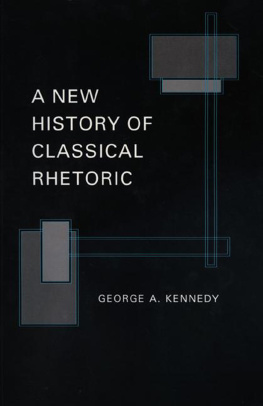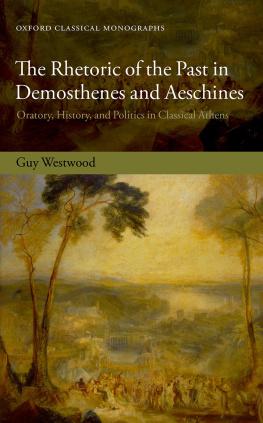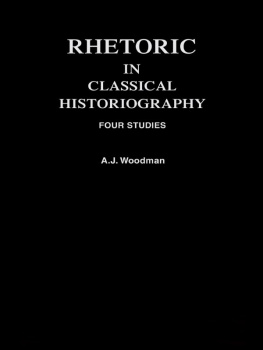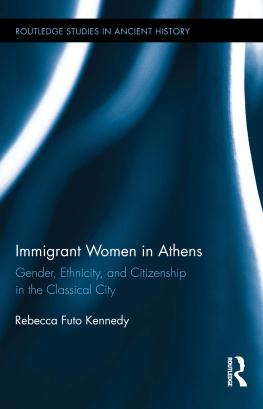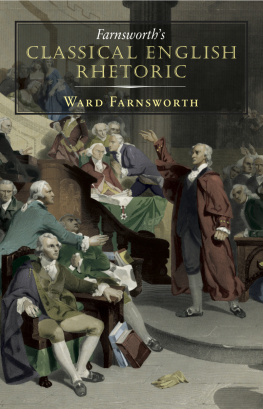Kennedy - A New History of Classical Rhetoric
Here you can read online Kennedy - A New History of Classical Rhetoric full text of the book (entire story) in english for free. Download pdf and epub, get meaning, cover and reviews about this ebook. City: Princeton;N.J, year: 1994, publisher: Princeton University Press, genre: Religion. Description of the work, (preface) as well as reviews are available. Best literature library LitArk.com created for fans of good reading and offers a wide selection of genres:
Romance novel
Science fiction
Adventure
Detective
Science
History
Home and family
Prose
Art
Politics
Computer
Non-fiction
Religion
Business
Children
Humor
Choose a favorite category and find really read worthwhile books. Enjoy immersion in the world of imagination, feel the emotions of the characters or learn something new for yourself, make an fascinating discovery.
- Book:A New History of Classical Rhetoric
- Author:
- Publisher:Princeton University Press
- Genre:
- Year:1994
- City:Princeton;N.J
- Rating:5 / 5
- Favourites:Add to favourites
- Your mark:
- 100
- 1
- 2
- 3
- 4
- 5
A New History of Classical Rhetoric: summary, description and annotation
We offer to read an annotation, description, summary or preface (depends on what the author of the book "A New History of Classical Rhetoric" wrote himself). If you haven't found the necessary information about the book — write in the comments, we will try to find it.
A New History of Classical Rhetoric — read online for free the complete book (whole text) full work
Below is the text of the book, divided by pages. System saving the place of the last page read, allows you to conveniently read the book "A New History of Classical Rhetoric" online for free, without having to search again every time where you left off. Put a bookmark, and you can go to the page where you finished reading at any time.
Font size:
Interval:
Bookmark:

A NEW HISTORY OF CLASSICAL RHETORIC
GEORGE A. KENNEDY
AN EXTENSIVE REVISION AND ABRIDGMENT OF
The Art of Persuasion in Greece
The Art of Rhetoric in the Roman World
AND
Greek Rhetoric under Christian Emperors
WITH ADDITIONAL DISCUSSION OF LATE LATIN RHETORIC
PRINCETON UNIVERSITY PRESS
PRINCETON, NEW JERSEY
Copyright 1994 by Princeton University Press
Published by Princeton University Press, 41 William Street,
Princeton, New Jersey 08540
In the United Kingdom: Princeton University Press,
Chichester, West Sussex
All Rights Reserved
Library of Congress Cataloging-in-Publication Data
Kennedy, George Alexander, 1928
A new history of classical rhetoric / George A. Kennedy.
p. cm.
An extensive revision and abridgment of The art of persuasion in Greece, The art of rhetoric in the Roman world, and Greek rhetoric under Christian emperors, with additional discussion of Late Latin rhetoric.
Includes bibliographical references and index.
ISBN 0-691-03443-5 (alk. paper) ISBN 0-691-00059-X (pbk. : alk. paper)
1. Rhetoric, Ancient. 2. Speeches, addresses, etc.,
GreekHistory and criticism. 3. Speeches, addresses, etc.,
LatinHistory and criticism. 4. Persuasion (Rhetoric)
5. Oratory, Ancient. I. Kennedy, George Alexander, 1928
Art of persuasion in Greece. II. Kennedy, George Alexander,
1928 Art of rhetoric in the Roman world.
III. Kennedy, George Alexander, 1928Greek
rhetoric under Christian emperors. IV. Title.
PA3038.K46 1994
808.04281dc20 94-11249
This book has been composed in Electra and Univers
Princeton University Press books are printed on
acid-free paper and meet the guidelines for permanence
and durability of the Committee on Production
Guidelines for Book Longevity of the
Council on Library Resources
Printed in the United States of America
10 9 8 7 6 5 4 3 2 1
10 9 8 7 6 5 4 3 2 1
(pbk.)
TO MY GRANDDAUGHTER,
AMY RUTH MORTON
This book is a revised history of rhetoric as that term was usually understood throughout classical antiquity: the art of persuasion by words or the art of civic discourse, taught and practiced in schools and applied in public address. It includes an account of rhetorical features of early Greek literature that anticipated the formulation of metarhetoric, or a theory of rhetoric, in the fifth and fourth centuries B.C., of the development of that theory throughout the Greco-Roman period, of the teaching of literary and oral composition in schools, and of Greek and Latin oratory as the primary rhetorical genre. The influence of rhetoric on literature other than oratory is only touched upon in passing. Since the formal disciplines of rhetoric and philosophy constantly interact, something is necessarily said about the history of ancient philosophy and its quarrel with, or acceptance of, rhetoric. Because the sophists of the Roman Empire were among the leading defenders of pagan religion, and because Christians borrowed many features of classical rhetoric for their own writing and preaching, later chapters of the book discuss the relationship of classical rhetoric to religion.
There is a sense in which a history of rhetoric might be thought of as a history of the values of a culture and how these were taught or imposed upon the society. Such a history would trace the formation and expression of idealogies and power structures and the uses of propaganda in the history of the culture. It would necessarily range widely, not only discussing the educational system, oratory, philosophy, religion, and literature of the culture, but also dealing with its art, architecture, city planning, political and economic institutions, class structure, gender relations, dress, food, and virtually everything that created and expressed what the culture was. This book does not attempt that formidable task, impossible in one book unless limited to a short historical period. It does, however, provide an account of one discipline that was a basic tool of power and cultural integrity in antiquity, and it also describes in some detail the system of classical rhetoric that continued to be studied and adapted, in a variety of ways, throughout the Middle Ages, the Renaissance, and the early modern period and that is again being studied widely today to gain understanding of rhetoric as a phenomenon of human life, language, and history.
Thirty years have passed since the publication of The Art of Persuasion in Greece. Both my own studies and the research of others have required significant revision of the account given there. Material from The Art of Rhetoric in the Roman World and Greek Rhetoric under Christian Emperors has required less change, but has here been shortened, rearranged, and somewhat revised. In writing now primarily for students, I have explained some features of ancient society more fully than scholars require, have eliminated much of the scholarly apparatus and bibliographical notes, for which the reader can consult the original volumes, and have added references to books and articles published since the date of my original works.
I am indebted to my colleague, Cecil W. Wooten, for many helpful suggestions and encouragement, and to Carol Roberts for her careful work as copy editor for Princeton University Press.
Chapel Hill
August 1993
A NEW HISTORY OF CLASSICAL RHETORIC
The English word rhetoric is derived from Greek rh torik
torik , which apparently came into use in the circle of Socrates in the fifth century and first appears in Platos dialogue Gorgias, probably written about 385 B.C. but set dramatically a generation earlier. Rh
, which apparently came into use in the circle of Socrates in the fifth century and first appears in Platos dialogue Gorgias, probably written about 385 B.C. but set dramatically a generation earlier. Rh torik
torik in Greek specifically denotes the civic art of public speaking as it developed in deliberative assemblies, law courts, and other formal occasions under constitutional government in the Greek cities, especially the Athenian democracy. As such, it is a specific cultural subset of a more general concept of the power of words and their potential to affect a situation in which they are used or received. Ultimately, what we call rhetoric can be traced back to the natural instinct to survive and to control our environment and influence the actions of others in what seems the best interest of ourselves, our families, our social and political groups, and our descendants. This can be done by direct actionforce, threats, bribes, for exampleor it can be done by the use of signs, of which the most important are words in speech or writing. Some concept of rhetoric, under different names, can be found in many ancient societies. In Egypt and China, for example, as in Greece, practical handbooks were written to advise the reader how to become an effective speaker.
in Greek specifically denotes the civic art of public speaking as it developed in deliberative assemblies, law courts, and other formal occasions under constitutional government in the Greek cities, especially the Athenian democracy. As such, it is a specific cultural subset of a more general concept of the power of words and their potential to affect a situation in which they are used or received. Ultimately, what we call rhetoric can be traced back to the natural instinct to survive and to control our environment and influence the actions of others in what seems the best interest of ourselves, our families, our social and political groups, and our descendants. This can be done by direct actionforce, threats, bribes, for exampleor it can be done by the use of signs, of which the most important are words in speech or writing. Some concept of rhetoric, under different names, can be found in many ancient societies. In Egypt and China, for example, as in Greece, practical handbooks were written to advise the reader how to become an effective speaker.
Classical writers regarded rhetoric as having been invented, or more accurately, discovered, in the fifth century B.C. in the democracies of Syracuse and Athens. What they mean by this is that then, for the first time in Europe, attempts were made to describe the features of an effective speech and to teach someone how to plan and deliver one. Under democracies citizens were expected to participate in political debate, and they were expected to speak on their own behalf in courts of law. A theory of public speaking evolved, which developed an extensive technical vocabulary to describe features of argument, arrangement, style, and delivery. In recent years, the term metarhetoric has been coined to describe a theory or art of rhetoric in contrast to the practice or application of the art in a particular discourse. The first teachers of rhetoric were the itinerent lecturers of fifth-century Greece known as sophists, to be discussed in the next chapter; beginning with Isocrates in the fourth century, regular schools of rhetoric became common, and throughout the Greco-Roman period the study of rhetoric was a regular part of the formal education of young men.
Font size:
Interval:
Bookmark:
Similar books «A New History of Classical Rhetoric»
Look at similar books to A New History of Classical Rhetoric. We have selected literature similar in name and meaning in the hope of providing readers with more options to find new, interesting, not yet read works.
Discussion, reviews of the book A New History of Classical Rhetoric and just readers' own opinions. Leave your comments, write what you think about the work, its meaning or the main characters. Specify what exactly you liked and what you didn't like, and why you think so.

